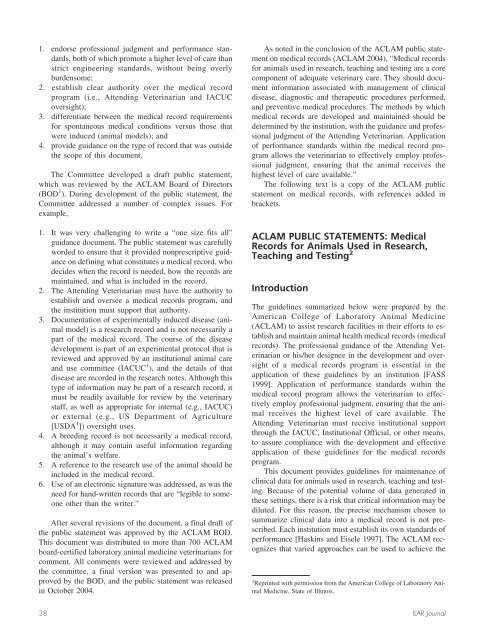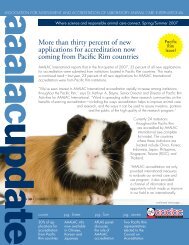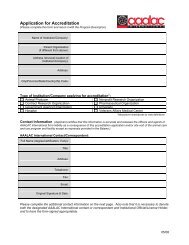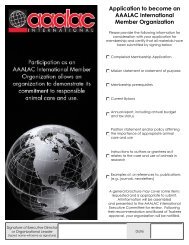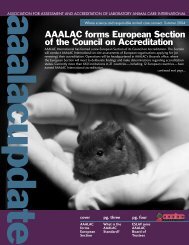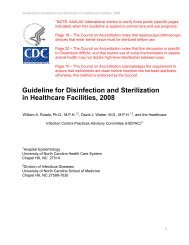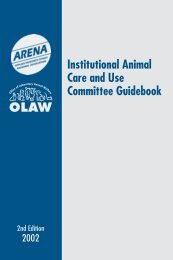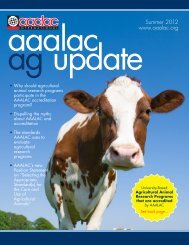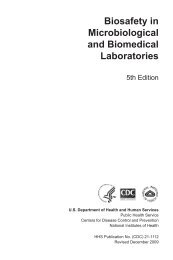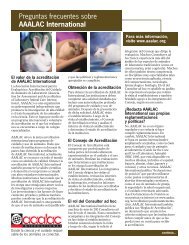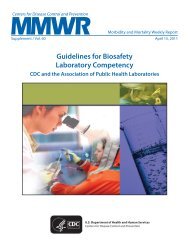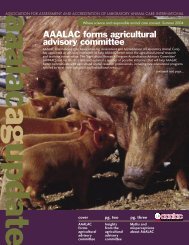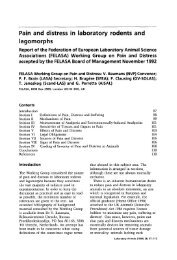Medical Records for Animals Used in Research, Teaching ... - Aaalac
Medical Records for Animals Used in Research, Teaching ... - Aaalac
Medical Records for Animals Used in Research, Teaching ... - Aaalac
Create successful ePaper yourself
Turn your PDF publications into a flip-book with our unique Google optimized e-Paper software.
1. endorse professional judgment and per<strong>for</strong>mance standards,both of which promote a higher level of care thanstrict eng<strong>in</strong>eer<strong>in</strong>g standards, without be<strong>in</strong>g overlyburdensome;2. establish clear authority over the medical recordprogram (i.e., Attend<strong>in</strong>g Veter<strong>in</strong>arian and IACUCoversight);3. differentiate between the medical record requirements<strong>for</strong> spontaneous medical conditions versus those thatwere <strong>in</strong>duced (animal models); and4. provide guidance on the type of record that was outsidethe scope of this document.The Committee developed a draft public statement,which was reviewed by the ACLAM Board of Directors(BOD 1 ). Dur<strong>in</strong>g development of the public statement, theCommittee addressed a number of complex issues. Forexample,1. It was very challeng<strong>in</strong>g to write a “one size fits all”guidance document. The public statement was carefullyworded to ensure that it provided nonprescriptive guidanceon def<strong>in</strong><strong>in</strong>g what constitutes a medical record, whodecides when the record is needed, how the records arema<strong>in</strong>ta<strong>in</strong>ed, and what is <strong>in</strong>cluded <strong>in</strong> the record.2. The Attend<strong>in</strong>g Veter<strong>in</strong>arian must have the authority toestablish and oversee a medical records program, andthe <strong>in</strong>stitution must support that authority.3. Documentation of experimentally <strong>in</strong>duced disease (animalmodel) is a research record and is not necessarily apart of the medical record. The course of the diseasedevelopment is part of an experimental protocol that isreviewed and approved by an <strong>in</strong>stitutional animal careand use committee (IACUC 1 ), and the details of thatdisease are recorded <strong>in</strong> the research notes. Although thistype of <strong>in</strong><strong>for</strong>mation may be part of a research record, itmust be readily available <strong>for</strong> review by the veter<strong>in</strong>arystaff, as well as appropriate <strong>for</strong> <strong>in</strong>ternal (e.g., IACUC)or external (e.g., US Department of Agriculture[USDA 1 ]) oversight uses.4. A breed<strong>in</strong>g record is not necessarily a medical record,although it may conta<strong>in</strong> useful <strong>in</strong><strong>for</strong>mation regard<strong>in</strong>gthe animal’s welfare.5. A reference to the research use of the animal should be<strong>in</strong>cluded <strong>in</strong> the medical record.6. Use of an electronic signature was addressed, as was theneed <strong>for</strong> hand-written records that are “legible to someoneother than the writer.”After several revisions of the document, a f<strong>in</strong>al draft ofthe public statement was approved by the ACLAM BOD.This document was distributed to more than 700 ACLAMboard-certified laboratory animal medic<strong>in</strong>e veter<strong>in</strong>arians <strong>for</strong>comment. All comments were reviewed and addressed bythe committee, a f<strong>in</strong>al version was presented to and approvedby the BOD, and the public statement was released<strong>in</strong> October 2004.As noted <strong>in</strong> the conclusion of the ACLAM public statementon medical records (ACLAM 2004), “<strong>Medical</strong> records<strong>for</strong> animals used <strong>in</strong> research, teach<strong>in</strong>g and test<strong>in</strong>g are a corecomponent of adequate veter<strong>in</strong>ary care. They should document<strong>in</strong><strong>for</strong>mation associated with management of cl<strong>in</strong>icaldisease, diagnostic and therapeutic procedures per<strong>for</strong>med,and preventive medical procedures. The methods by whichmedical records are developed and ma<strong>in</strong>ta<strong>in</strong>ed should bedeterm<strong>in</strong>ed by the <strong>in</strong>stitution, with the guidance and professionaljudgment of the Attend<strong>in</strong>g Veter<strong>in</strong>arian. Applicationof per<strong>for</strong>mance standards with<strong>in</strong> the medical record programallows the veter<strong>in</strong>arian to effectively employ professionaljudgment, ensur<strong>in</strong>g that the animal receives thehighest level of care available.”The follow<strong>in</strong>g text is a copy of the ACLAM publicstatement on medical records, with references added <strong>in</strong>brackets.ACLAM PUBLIC STATEMENTS: <strong>Medical</strong><strong>Records</strong> <strong>for</strong> <strong>Animals</strong> <strong>Used</strong> <strong>in</strong> <strong>Research</strong>,Teach<strong>in</strong>g and Test<strong>in</strong>g 2IntroductionThe guidel<strong>in</strong>es summarized below were prepared by theAmerican College of Laboratory Animal Medic<strong>in</strong>e(ACLAM) to assist research facilities <strong>in</strong> their ef<strong>for</strong>ts to establishand ma<strong>in</strong>ta<strong>in</strong> animal health medical records (medicalrecords). The professional guidance of the Attend<strong>in</strong>g Veter<strong>in</strong>arianor his/her designee <strong>in</strong> the development and oversightof a medical records program is essential <strong>in</strong> theapplication of these guidel<strong>in</strong>es by an <strong>in</strong>stitution [FASS1999]. Application of per<strong>for</strong>mance standards with<strong>in</strong> themedical record program allows the veter<strong>in</strong>arian to effectivelyemploy professional judgment, ensur<strong>in</strong>g that the animalreceives the highest level of care available. TheAttend<strong>in</strong>g Veter<strong>in</strong>arian must receive <strong>in</strong>stitutional supportthrough the IACUC, Institutional Official, or other means,to assure compliance with the development and effectiveapplication of these guidel<strong>in</strong>es <strong>for</strong> the medical recordsprogram.This document provides guidel<strong>in</strong>es <strong>for</strong> ma<strong>in</strong>tenance ofcl<strong>in</strong>ical data <strong>for</strong> animals used <strong>in</strong> research, teach<strong>in</strong>g and test<strong>in</strong>g.Because of the potential volume of data generated <strong>in</strong>these sett<strong>in</strong>gs, there is a risk that critical <strong>in</strong><strong>for</strong>mation may bediluted. For this reason, the precise mechanism chosen tosummarize cl<strong>in</strong>ical data <strong>in</strong>to a medical record is not prescribed.Each <strong>in</strong>stitution must establish its own standards ofper<strong>for</strong>mance [Hask<strong>in</strong>s and Eisele 1997]. The ACLAM recognizesthat varied approaches can be used to achieve the2 Repr<strong>in</strong>ted with permission from the American College of Laboratory AnimalMedic<strong>in</strong>e, State of Ill<strong>in</strong>ois.38 ILAR Journal


